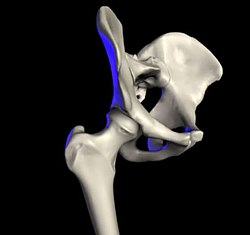Acetabular angle
| Hip | |
|---|---|

Bones of the hip region
|
|
| Details | |
| Identifiers | |
| Latin | coxa |
| MeSH | A01.378.610.400 |
| Dorlands /Elsevier |
12422739 |
| TA | A01.1.00.034 |
| FMA | 24964 |
|
Anatomical terminology
[]
|
|
In vertebrate anatomy, hip (or "coxa" in medical terminology) refers to either an anatomical region or a joint.
The hip region is located lateral and anterior to the gluteal region (i.e., the buttock), inferior to the iliac crest, and overlying the greater trochanter of the femur, or "thigh bone". In adults, three of the bones of the pelvis have fused into the hip bone or acetabulum which forms part of the hip region.
The hip joint, scientifically referred to as the acetabulofemoral joint (art. coxae), is the joint between the femur and acetabulum of the pelvis and its primary function is to support the weight of the body in both static (e.g. standing) and dynamic (e.g. walking or running) postures. The hip joints are the most important part in retaining balance. The pelvic inclination angle, which is the single most important element of human body posture, is mostly adjusted at the hips.
Pain of the hip may be the result of numerous causes including nervous, osteoarthritic, infectious, trauma-related, and genetic ones.
The five or so tubercles and the lower lateral borders of the sacrum, and the ischial tuberosity ("sitting bone").
The hip joint is a synovial joint formed by the articulation of the rounded head of the femur and the cup-like acetabulum of the pelvis. It forms the primary connection between the bones of the lower limb and the axial skeleton of the trunk and pelvis. Both joint surfaces are covered with a strong but lubricated layer called articular hyaline cartilage.
...
Wikipedia
